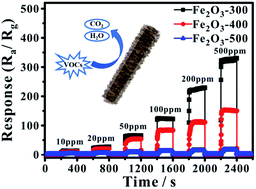Nanosheet-assembled, hollowed-out hierarchical γ-Fe2O3 microrods for high-performance gas sensing†
Abstract
Preventing the stacking of two-dimensional (2D) structured nanomaterials is important for developing high-performance gas sensors. To address this challenge, three-dimensional (3D) hollowed-out hierarchical Fe2O3 microrods assembled by nanosheets were successfully fabricated via a facile MgO-mediated chemical template conversion strategy. Structurally, the large active surface area of the microrods significantly enhanced gas adsorption, thereby resulting in a high response. Additionally, the hollow interior and the well-aligned porous structure between adjacent nanosheets were favorable for the rapid diffusion of detected gases, reducing the response/recovery times. Gas sensing measurements revealed that the nanosheet-assembled, hollowed-out hierarchical γ-Fe2O3 microrods calcined at 300 °C (i.e., Fe2O3-300) exhibited the best performance among the as-prepared samples with different phases. Strikingly, the sensitivity to 100 ppm acetone at 220 °C reached 125.5, and the response/recovery times were only 0.9/15 s, respectively. Compared to α-Fe2O3 obtained at 500 °C (i.e., Fe2O3-500), Fe2O3-300 with the γ-phase exhibits superior capacity to chemisorb oxygen and the bulk resistance effect, which are intrinsically beneficial for enhancing its gas sensing performance. In addition, the as-synthesized nanosheet-assembled, hollowed-out hierarchical γ-Fe2O3 microrods exhibited outstanding repeatability and remarkable long-term stability, which suggests their potential application in fabricating highly sensitive gas sensors. This work provides a viable approach for synthesizing various nanosheet-assembled, hollowed-out hierarchical metal oxides.



 Please wait while we load your content...
Please wait while we load your content...